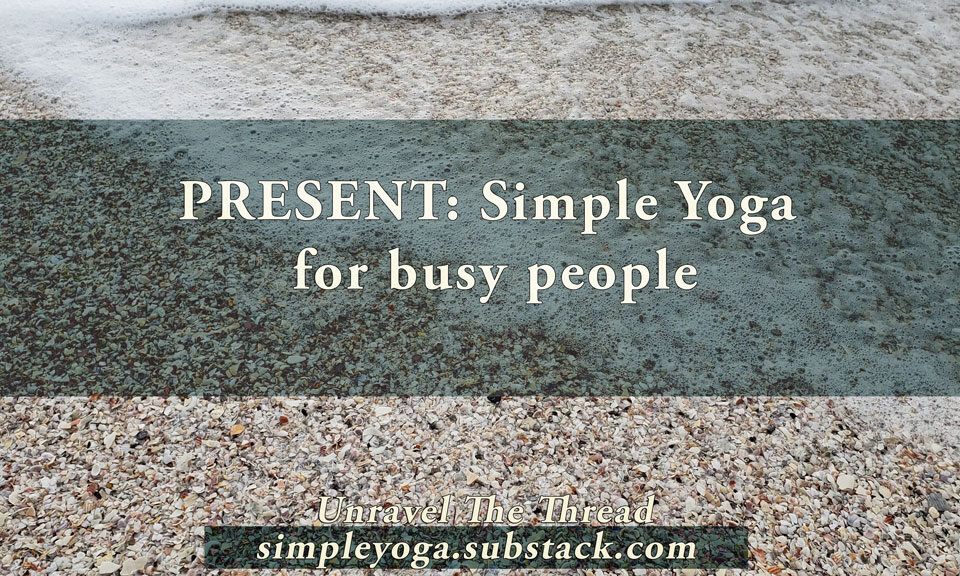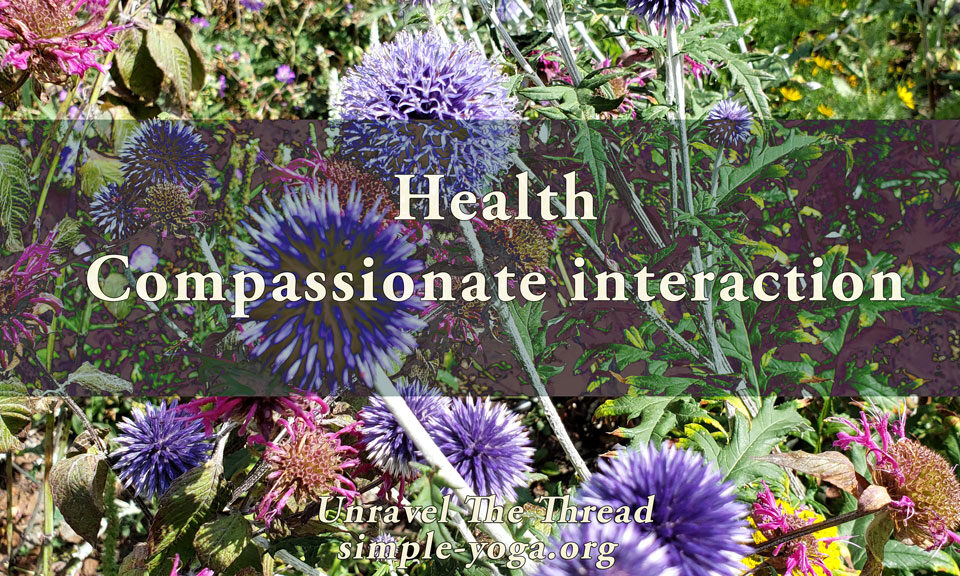Inspired Practice
March 9, 2008Relaxing at the end of the day
April 15, 2008Inspired Practice
March 9, 2008Relaxing at the end of the day
April 15, 200810 minute Yoga practice



If you would like to practice at home, here is a 10 minute practice session that can be adapted and modified according to your needs. (If you have not read the disclaimer yet, please do. )
Suggestions
Read the suggestions and the instructions and print the diagram for reference. Keep in mind these suggestions that may help as you practice:
- Use ujjayi breathing throughout the practice.
- Synchronize your movements with your breath.
- Make each pose a perfect balance between relaxation and stability.
- Keep in mind that that there is never pain in Yoga practice.
- Remember to relax your face, gaze and shoulders.
The practice
- Centering – Start lying down on the floor on a folded blanket or Yoga mat with your knees bent, your feet flat on the floor and your arms resting by the sides of your torso. Let go of whatever is not in the present moment by focusing on the natural rhythm of the breath, noticing your level of energy, and paying attention to any sensations that emerge. After a few breaths, switch from natural breath to ujjayi breath for both the inhalation (IN) and the exhalation (EX) without forcing.
- As you inhale lift your arms up, taking the arms over and down to the floor by the sides of your head. On exhalation return your arms to the initial position. Repeat 5 times.
- Apanasana – On exhalation, lift both feet off the floor rest each hand on its corresponding knee and bring both knees toward your chest without forcing. Inhale pushing your knees gently away from the chest. Repeat 4 times.
- Dvipada Pitham – Return your feet and arms to the floor. Align your heels with your sitting bones. As you inhale press both feet firmly on the floor and lift your hips and arms. When the hips reach the highest point the arms reach the floor by the sides of your head. On exhalation, return the arms and hips to the initial position. Repeat 4 times.
- Chakravakasana – Roll around bringing your shinbones to rest on the floor and draping your front torso on your thighs while stretching your arms out in front of you. Separate your hands as wide as your shoulders and spread your fingers while pressing them on the floor, this is extended child pose. On inhalation press the hands on the floor and come to your hands and knees keeping the knees directly under your hip joints, flatten your upper back and look forward. On exhalation, return to the extended child pose. Repeat 4 times.
- Vajrasana – From extended child pose bring the backs of your hands to rest on the back of your pelvis. As you inhale lift the ribcage and arms and come to standing on your knees with your arms lifted over your head. When you exhale return to the modified child’s pose with the hands on the back of the pelvis. Repeat 4 times.
- Ekapada Ustrasana – Lift from child’s pose to standing on your knees, bring the right foot forward so that the right heel is directly under the right knee. Rest your right hand on the right thigh while allowing your left arm to hang by your side. Inhale bending the right knee and lifting the ribcage and left arm up. On exhalation, return to the starting position. Repeat 4 times and then repeat 4 times with the left foot forward.
- Tadasana – Stand straight, with your feet firmly planted on the floor, keeping the body weight equally balanced between the front of the feet and the heels. Also, balance the body weight between the left foot and the right foot and allow your pelvis to be level, that is, not tipping forward or back. Soften the shoulders and roll them back and down. Take 3 deep breaths and feel the sensations in your body.
- Urdhva Hastasana – From Tadasana, inhale lifting both arms up in front of you as far as it is appropriate for you. Remember to keep your shoulders relaxed and maybe try to initiate the movement from your navel. On exhalation, return to Tadasana. Repeat 4 times.
- Ardha Chandrasana – From Tadasana, inhale lifting your arms to the sides and up, as you exhale tilt your pelvis to the right side taking the right hand and arm towards the right thigh while keeping the left arm moving over the head and to the right side. Inhale lifting both arms up and exhale tilting your pelvis to the left while taking your left hand and arm down towards the left thigh. Repeat 3 times.
- Ardha Uttanasana – From Tadasana, inhale lifting the arms all the way up over your head. On exhalation tilt forward at the hip joints leading with your chest while opening the arms to the sides until your torso is parallel to the floor. If you feel tightness in the back of your thighs bend your knees to release tension as you fold forward. Inhale returning all the way up and on the following exhalation return to Tadasana. Repeat 4 times.
- Virabhadrasana I – From Tadasana, inhale taking a comfortable step forward with your right leg and lift both arms up. Press firmly with both feet on the ground, exhale bending the right knee towards a 90 degree angle. When you inhale press the right foot on the floor straightening the right leg. Repeat 3 times. On exhalation return to Tadasana.
- Ardha Utkatasana – From Tadasana, inhale lifting both arms up (Urdhva Hastasana). As you exhale bend your knees as far as it is comfortable. Inhaling, press both feet on the floor to return to Urdhva Hastasana. Repeat 3 times. On the final exhalation, return to Tadasana.
- Sukhasana – Sit on the floor with your legs crosses for 3 full breaths, noticing the sensations in your body.
- Urdhva Prasarita Padasana – Recline onto your back resting your hands and arms on the floor alongside your body. Bend your knees and lift your feet of the floor. As you inhale, lift both arms up continuing the movement until the arms rest down on the floor by the sides of your head. At the same time stretch your legs up to the sky. On exhalation return to the starting position. Repeat 4 times.
- Jathara Parivarttanasana – Inhale spreading your arms to the sides at shoulder level while keeping the knees bent. On exhalation keep your shoulders in contact with the floor while dropping the knees to the right side. Inhale returning the knees to the center and on exhalation drop the knees to the left. Repeat 4 times.
- Apanasana – On exhalation, lift both feet off the floor, rest each hand on its corresponding knee and bring both knees toward your chest without forcing. Inhale pushing your knees gently away from the chest. Repeat 4 times.
- Savasana – Lie on your back with legs straight and heels 2-3 feet apart and your arms resting on the floor, each hand a foot away from the body and the palms facing up. You can also lie on the floor with your knees bent and the arms to the sides and the palms facing up. Relax completely, letting go of any control over breath and body. Rest observing your breath quietly for at least 12 rounds of effortless spontaneous breath.
Diagram of 10 minute Yoga practice
Make it YOUR Practice
This sequence is only a suggestion. Of course, since Yoga is a path of self-learning always adapt and modify the poses and the number of repetitions so the practice is perfect, not too much and not too little, for you. This can be a good way to start practicing at home and to supplement any classes you attend regularly.
Noticing the effects
See what happens when you practice 2 or 3 times a week for 3 or 4 weeks. Observe how you feel before and after your practice. There might be differences at the physical, mental and emotional levels. What do you notice? Do you feel different in any way? What does your practice do for you? Do you notice any differences in how you feel or behave during the day? Do you feel that you have more or less energy? Does practicing affect your mood or the way you sleep?
Answering these questions gives you insight on your practice and on its relationship to your every day life.
I hope you enjoy your practice!
Namaste.
Simple guided meditation with Rubén



